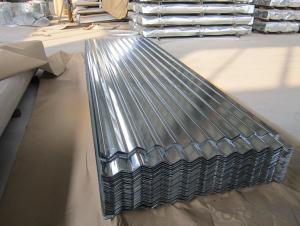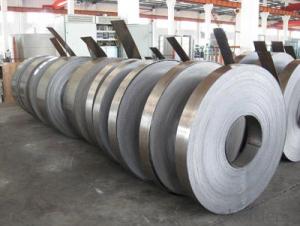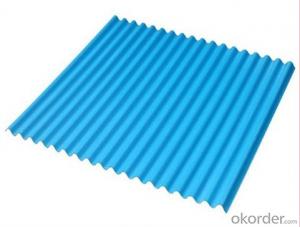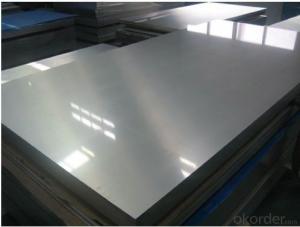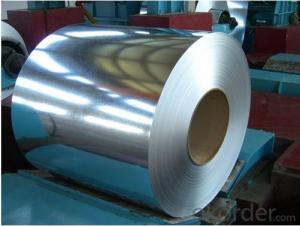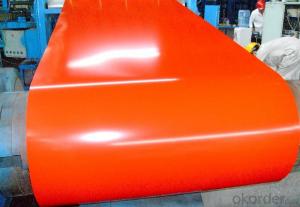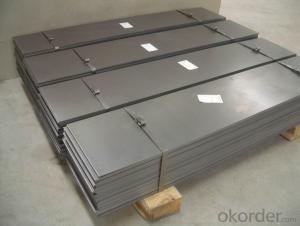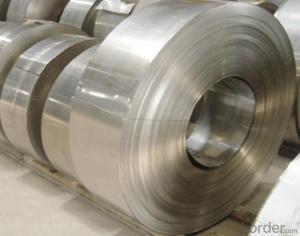Hot-dip Aluzinc Steel Building Roof Walls 615-009-01
- Loading Port:
- Tianjin
- Payment Terms:
- TT OR LC
- Min Order Qty:
- 66 kg/m²
- Supply Capability:
- 11 kg/m²/month
OKorder Service Pledge
OKorder Financial Service
You Might Also Like
. Description of the Hot-dip Aluzinc Steel:
Hot-dip aluzinc steel structure is composed of aluminum-zinc alloy, consisting of 55% aluminum, 43% zinc and 2% at 600 ℃ silicon solidification temperature and composition, the entire structure is made of aluminum - iron - silicon - zinc, to form a dense quaternary crystals an alloy.
Hot-dip aluzinc steel has many excellent features: strong corrosion resistance, is three times the pure galvanized sheet; zinc surface with beautiful flowers, can be used as a building outside board.
Applications of hot-dip aluzinc steel:
1)Building: roof, walls, garages, soundproof walls, pipes and modular housing.
2)Automotive: muffler, exhaust pipes, wiper accessories, fuel tank, truck boxes, etc.
3)Appliances: refrigerator back, gas stove, air conditioners, microwave oven, LCD frame, 4)CRT-proof band, LED backlight, electrical cabinets, etc.
5)Farm: barn, sheds, silos, piping and other greenhouse.
6)Other: breaking heat insulation cover, heat exchangers, dryers, warm water, etc.
Although steel had been produced in bloomery furnaces for thousands of years, steel's use expanded extensively after more efficient production methods were devised in the 17th century for blister steel and then crucible steel. With the invention .
2.Main Features of the Hot-dip Aluzinc Steel:
• Excellent corrosion resistance
• High temperature oxidation resistance
• High hot reflectance
• Good manufacturability
•Beautiful appearance
•Surface coating
•Cost-effective
3.Hot-dip Aluzinc Steel Images

4.Hot-dip Aluzinc Steel Specification
AVAILABLE SPECIFICATION
HOT-DIP ALUZINC STEEL COILS | |
THICKNESS | 0.16mm-3.5mm |
WIDTH | 1250mm MAX |
COATING MASS | |
SPANGLE | Regular Spangle, Minimized Spangle, Zero Spangle |
SURFACE TREATMENT | Chromated / non-chromated, Oiled / non-oiled, Anti Finger Print |
COIL INNER DIAMETER | 508mm or 610mm |
5.FAQ of Hot-dip Aluzinc Steel
We have organized several common questions for our clients,may help you sincerely:
1.What advantages does your company have?
Cement : Annual capacity of 400 million tons, No. 1 in the world
Fiberglass: Annual capacity of 1 million tons fiberglass, No. 1 in the world.
2.What advantages do your products have?
Firstly, our base material is of high quality, Their performance is in smooth and flat surface,no edge wave ,good flexibility.
Secondly, high quality zinc ingoats, 97.5% zinc,1.5% silicon,1% others, the same zinc coating measured by metal coating thickness or by zinc weight
Thirdly, high precision: Tolerance strictly according to ASTM or JISG standard even more rigid.
We have full stes of testing equipment(for t best, cupule,chromatism,salt spray resistance, etc) and professional engineers.
3.Could you let me approach about your company in Dubai?
Located at Jebel Ali Free Zone in Dubai, CNBM Dubai Logistics Complex is adjacent to -Jebel Ali sea port-the largest port in UAE and Al Maktoum Airport-
- Q:How do steel strips compare to other materials in terms of cost?
- Steel strips are generally more cost-effective compared to other materials due to their lower production costs and abundant availability in the market.
- Q:How are steel strips tested for hardness?
- Steel strips are typically tested for hardness using a method called the Rockwell hardness test. This involves applying a specific amount of force to the surface of the steel strip using a diamond or carbide ball indenter, and then measuring the depth of the indentation. The hardness value is determined based on the depth of the indentation, providing an accurate measure of the steel strip's hardness.
- Q:How are steel strips used in the production of hand tools?
- Steel strips are commonly used in the production of hand tools as they provide strength, durability, and flexibility. These strips are often shaped, molded, or stamped to form the various components of hand tools, such as blades, handles, or springs. The high-quality steel used in these strips ensures that hand tools can withstand heavy usage, resist corrosion, and maintain their sharpness over time. Overall, steel strips are essential in creating reliable and long-lasting hand tools that can effectively perform a wide range of tasks.
- Q:What are the different welding techniques used for joining steel strips?
- Some of the different welding techniques used for joining steel strips include MIG (Metal Inert Gas) welding, TIG (Tungsten Inert Gas) welding, resistance welding, and laser welding. These techniques offer various advantages and are chosen based on factors such as the thickness of the steel strips, the desired strength of the joint, and the specific application requirements.
- Q:How are steel strips processed for waterjet cutting?
- Precision and accuracy are ensured in the waterjet cutting process of steel strips through a series of steps. Initially, the surfaces of the steel strips are cleaned and prepared by eliminating any dirt, debris, or rust. The objective is to establish a clean and smooth cutting surface. Once the cleaning process is completed, the steel strips are placed onto a waterjet cutting machine. This machine is equipped with a high-pressure waterjet nozzle that expels a stream of water combined with an abrasive material, typically garnet, at incredibly high speeds. The waterjet possesses the capability of cutting the steel strips with exceptional precision. Prior to commencing the actual cutting process, the waterjet cutting machine is programmed with specific cutting parameters. These parameters encompass the desired dimensions, shapes, and angles of the steel strips. By using specialized software, the machine operator inputs these parameters, which are then translated into instructions for the waterjet cutting machine. When the cutting parameters have been set, the machine operator initiates the cutting process. The high-pressure waterjet is directed onto the steel strip, successfully cutting through it with extreme accuracy. The waterjet has the capacity to cut through steel of various thicknesses, ranging from thin strips to thicker plates, depending on the capabilities of the machine. Throughout the cutting process, continuous monitoring of the waterjet ensures that the desired dimensions and shapes are being attained. If necessary, the machine operator may make adjustments to the cutting parameters in order to maintain accuracy. Upon completion of the waterjet cutting, the steel strips are meticulously extracted from the machine. Additional processing, such as deburring or sanding, may be conducted to guarantee a smooth and refined edge. In conclusion, the process of waterjet cutting steel strips encompasses the cleaning and preparation of the strips, programming the cutting parameters, and utilizing a high-pressure waterjet for precise cutting of the steel. This method is renowned for its accuracy, versatility, and ability to cut through steel of varying thicknesses.
- Q:Are steel strips suitable for electrical applications?
- Yes, steel strips are suitable for electrical applications. They offer excellent conductivity, durability, and magnetic properties, making them ideal for various electrical components, such as transformers, inductors, and motors. Additionally, steel strips can be easily fabricated, have good heat dissipation capabilities, and are cost-effective, further enhancing their suitability for electrical applications.
- Q:How are steel strips protected against damage during handling?
- Steel strips are protected against damage during handling through various measures such as applying protective coatings, packaging them in sturdy materials, using proper lifting and handling equipment, and implementing careful handling techniques to minimize the risk of impacts or bending.
- Q:What are the different surface treatments for steel strips to enhance adhesion?
- Some of the different surface treatments for steel strips to enhance adhesion include cleaning and degreasing the surface, applying a primer or conversion coating, and using methods such as sandblasting or chemical etching to improve surface roughness. Additionally, electroplating or applying a thin layer of zinc or other metals can provide a protective coating and further enhance adhesion.
- Q:Can steel strips be used for making electrical enclosures?
- Certainly, electrical enclosures can indeed be manufactured using steel strips. The reason for steel being a popular choice for producing electrical enclosures is due to its strength and durability. By shaping and fabricating steel strips, one can create electrical enclosures of different sizes and designs to meet specific requirements. In addition, steel effectively safeguards electrical components from environmental elements like moisture, dust, and debris, making it an ideal material for enclosing them. To further enhance corrosion resistance and increase the lifespan of the electrical enclosure, the steel strips can also be treated with coatings like powder coating or galvanization. All in all, steel strips offer a dependable and sturdy option for constructing electrical enclosures.
- Q:How do steel strips contribute to product safety in various applications?
- Product safety in various applications is enhanced through the utilization of steel strips, which offer several notable advantages. Firstly, their exceptional strength and durability make them a preferred choice for products requiring long-lasting materials. This feature significantly reduces the risk of structural failures and potential hazards, ultimately improving overall product safety. Furthermore, steel strips exhibit remarkable resistance to corrosion, making them suitable for industries exposed to moisture, chemicals, or extreme weather conditions. By remaining intact and functional over an extended period, the risk of accidents or malfunctions is significantly reduced. Additionally, steel strips possess excellent fire resistance properties due to their high melting point and non-combustible nature. Consequently, they are highly suitable for applications where fire safety is crucial, such as construction, automotive, or electrical industries. The utilization of steel strips substantially diminishes the likelihood of fire-related accidents. Moreover, steel strips can be engineered and customized to fulfill specific safety requirements. By incorporating various coatings, such as anti-slip or reflective coatings, safety can be enhanced in applications like staircases, walkways, or road signs. Additionally, the strips can be designed with specific profiles or shapes to provide improved grip, stability, or support, further bolstering product safety. Furthermore, the uniformity and consistency in the physical properties of steel strips ensure reliable product performance. This predictability allows designers and engineers to accurately assess safety factors during the design and manufacturing stages. By employing a dependable material, the risk of unexpected failures or accidents resulting from material weaknesses is greatly minimized, guaranteeing a safer end product. In conclusion, steel strips play a vital role in enhancing product safety across various applications. Their attributes, such as high strength, durability, corrosion resistance, fire resistance, customization options, and reliability, make them an optimal material choice for improving safety and overall product performance.
1. Manufacturer Overview |
|
|---|---|
| Location | |
| Year Established | |
| Annual Output Value | |
| Main Markets | |
| Company Certifications | |
2. Manufacturer Certificates |
|
|---|---|
| a) Certification Name | |
| Range | |
| Reference | |
| Validity Period | |
3. Manufacturer Capability |
|
|---|---|
| a)Trade Capacity | |
| Nearest Port | |
| Export Percentage | |
| No.of Employees in Trade Department | |
| Language Spoken: | |
| b)Factory Information | |
| Factory Size: | |
| No. of Production Lines | |
| Contract Manufacturing | |
| Product Price Range | |
Send your message to us
Hot-dip Aluzinc Steel Building Roof Walls 615-009-01
- Loading Port:
- Tianjin
- Payment Terms:
- TT OR LC
- Min Order Qty:
- 66 kg/m²
- Supply Capability:
- 11 kg/m²/month
OKorder Service Pledge
OKorder Financial Service
Similar products
New products
Hot products
Hot Searches
Related keywords







